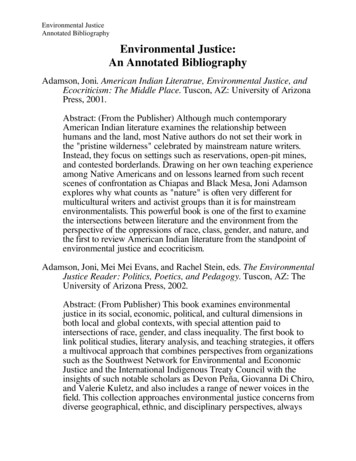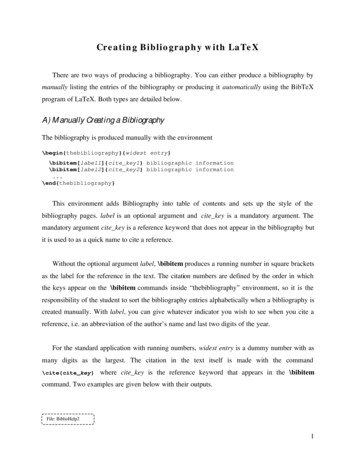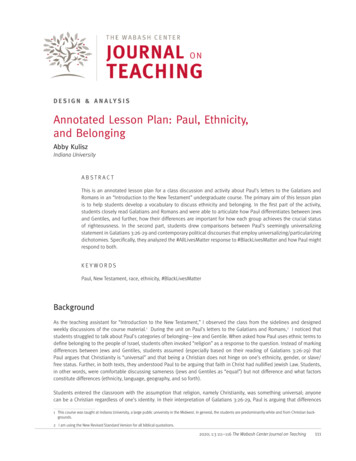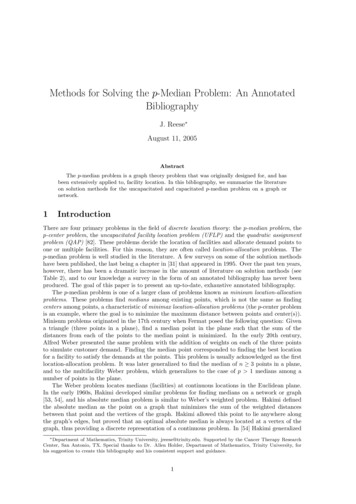
Transcription
Environmental JusticeAnnotated BibliographyEnvironmental Justice:An Annotated BibliographyAdamson, Joni. American Indian Literatrue, Environmental Justice, andEcocriticism: The Middle Place. Tuscon, AZ: University of ArizonaPress, 2001.Abstract: (From the Publisher) Although much contemporaryAmerican Indian literature examines the relationship betweenhumans and the land, most Native authors do not set their work inthe "pristine wilderness" celebrated by mainstream nature writers.Instead, they focus on settings such as reservations, open-pit mines,and contested borderlands. Drawing on her own teaching experienceamong Native Americans and on lessons learned from such recentscenes of confrontation as Chiapas and Black Mesa, Joni Adamsonexplores why what counts as "nature" is often very different formulticultural writers and activist groups than it is for mainstreamenvironmentalists. This powerful book is one of the first to examinethe intersections between literature and the environment from theperspective of the oppressions of race, class, gender, and nature, andthe first to review American Indian literature from the standpoint ofenvironmental justice and ecocriticism.Adamson, Joni, Mei Mei Evans, and Rachel Stein, eds. The EnvironmentalJustice Reader: Politics, Poetics, and Pedagogy. Tuscon, AZ: TheUniversity of Arizona Press, 2002.Abstract: (From Publisher) This book examines environmentaljustice in its social, economic, political, and cultural dimensions inboth local and global contexts, with special attention paid tointersections of race, gender, and class inequality. The first book tolink political studies, literary analysis, and teaching strategies, it offersa multivocal approach that combines perspectives from organizationssuch as the Southwest Network for Environmental and EconomicJustice and the International Indigenous Treaty Council with theinsights of such notable scholars as Devon Peña, Giovanna Di Chiro,and Valerie Kuletz, and also includes a range of newer voices in thefield. This collection approaches environmental justice concerns fromdiverse geographical, ethnic, and disciplinary perspectives, always
Environmental Justice Annotated Bibliography2viewing environmental issues as integral to problems of socialinequality and oppression. It offers new case studies of nativeAlaskans' protests over radiation poisoning; Hispanos' struggles toprotect their land and water rights; Pacific Islanders' resistance tonuclear weapons testing and nuclear waste storage; and the efforts ofwomen employees of maquiladoras to obtain safer living andworking environments along the U.S.-Mexican border. Theselections also include cultural analyses of environmental justice arts,such as community art and greening projects in inner-city Baltimore,and literary analyses of writers such as Jimmy Santiago Baca, LindaHogan, Barbara Neely, Nez Perce orators, Ken Saro-Wiwa, andKaren Yamashita—artists who address issues such as toxicity andcancer, lead poisoning of urban African American communities, andNative American struggles to remove dams and save salmon. Thebook closes with a section of essays that offer models to teachershoping to incorporate these issues and texts into their classrooms. Bycombining this array of perspectives, this book makes the field ofenvironmental justice more accessible to scholars, students, andconcerned readers.Adger, W. Niel, Jouni Paavola, and Saleemul Huq, eds. Fairness inAdaptation to Climate Change. Cambridge, MA: MIT Press, 2006.Abstract: (From Publisher) As a global society, we need to takeaction not only to prevent the potentially catastrophic effects ofclimate change but also to adapt to the unavoidable effects of climatechange already imposed on the world. Fairness in Adaptation toClimate Change looks at the challenges of ensuring that policyresponses to climate change do not place undue and unfair burdenson already vulnerable populations. All countries will be endangeredby climate change risks from floods, drought, and other extremeweather events, but developing countries are more dependent onclimate-sensitive livelihoods such as farming and fishing and henceare more vulnerable. Despite this, the concerns of developingcountries are marginalized in climate policy decisions thatexacerbate current vulnerabilities.Agyeman, Julian. Sustainable Communities and the Challenge ofEnvironmental Justice. New York, NY: New York University Press,2005.
Environmental Justice Annotated Bibliography3Abstract (From Publisher): Popularized in the movies ErinBrockovich and A Civil Action, environmental justice refers to anylocal response to a threat against community health. In this book,Julian Agyeman argues that environmental justice and thesustainable communities movement are compatible in practical ways.Yet sustainability, which focuses on meeting our needs today whilenot compromising the ability of our successors to meet their needs,has not always partnered with the challenges of environmentaljustice. Sustainable Communities and the Challenge ofEnvironmental Justice explores the ideological differences betweenthese two groups and shows how they can work together. Agyemanprovides concrete examples of potential model organizations thatemploy the types of strategies he advocates. This book is vital to theefforts of community organizers, policymakers, and everyoneinterested in a better environment and community health.Agyeman, Julian, Robert Bullard, and Bob Evans, eds. JustSustainabilities: Development in an Unequal World. Boston, MA:The MIT Press, 2003.Abstract (From Publisher): Environmental activists and academicsalike are realizing that a sustainable society must be a just one.Environmental degradation is almost always linked to questions ofhuman equality and quality of life. Throughout the world, thosesegments of the population that have the least political power and arethe most marginalized are selectively victimized by environmentalcrises. Just Sustainabilities argues that social and environmentaljustice within and between nations should be an integral part of thepolicies and agreements that promote sustainable development. Thebook addresses many aspects of the links between environmentalquality and human equality and between sustainability andenvironmental justice more generally. The topics discussed includeanthropocentrism; biotechnology; bioprospecting; bioculturalassimilation; deep and radical ecology; ecological debt; ecologicaldemocracy; ecological footprints; ecological modernization; feminismand gender; globalization; participatory research; place, identity, andlegal rights; precaution; risk society; selective victimization; andvaluation.
Environmental Justice Annotated Bibliography4Ahern, Annette. “Preservation by 'Letting Go': Buddhist Impermanence(Anicca) in Ruether's Ecotheology.” Ecotheology: Journal ofReligion, Nature & the Environment. 11.2(2006): 212-232.From Abstract: Christianity, Judaism and Buddhism contain richteaching and motivational resources that pertain directly to thestruggle for environmental justice in this age of what EngagedBuddhist leader Sulak Sivaraksa identifies as global militaristiccapitalism. Guided by the work of ecofeminist theologian RosemaryRuether and Buddhist scholar Rita Gross, this paper exploresmeanings and symbols within Judaism, Christianity, and Buddhismthat promote environmental values and practice. The paper beginswith an overview of Ruether's interpretation of the covenantal andsacramental traditions in Judaism and Christianity (1992 and 2000)followed by a close look at the dialogue between Gross and Ruether(2001) in which the relevance of the Buddhist teachings concerningimpermanence (anicca) and interdependence for the environmentalmovement is unfolded. This article concludes by articulating adifferent interpretive strategy for accessing the Christian communitythan that provided by Ruether while at the same time building on herwork.Akinade, Akintunde E. “Kinship with All Creation : An AfricanReflection on Eco-Justice.” In Living Pulpit, 9.2(Ap-Je 2000): 22.Allen, Barbara. Uneasy Alchemy: Citizens and Experts in Louisiana’sChemical Corridor Disputes. Cambridge, MA: The MIT Press,2003.Abstract: (From Publisher) Louisiana annually reports over eighttons of toxic waste for each citizen. Uneasy Alchemy examines therole of experts -- lawyers, economists, health professionals, andscientists -- in the struggles for environmental justice in the state'sinfamous Chemical Corridor or "Cancer Alley." This legendarytoxic zone between New Orleans and Baton Rouge is home to about125 oil and chemical plants; cancer and respiratory illness rates thereare among the highest in the nation. The efforts of residents to ensurea healthy environment is one of the most important social justicemovements of the post-civil rights era.
Environmental Justice Annotated Bibliography5Anand, Ruchi. International Environmental Justice: A North-SouthDimension. Aldershot, England: Ashgate, 2004.Abstract: (From Publisher) This important work satisfies the need fora thorough assessment of environmental justice concerns at theglobal level. Using three international environmental case studies, thebook extends the theory of environmental justice, commonly used indomestic settings, to the international arena of environmental law,policy and politics. Spanning the traditional boundaries betweenpolitical science, international relations, international law,international political economy and policy studies, this text isintended primarily for scholars of environmental justice, national andinternational policymakers, businesses, activists and students ofinternational environmental law, public policy and political economyof the third world.Andiñach, Pablo R. “In defence of life.” Trans. by Jody Pavilack. InStudies in World Christianity 8.2(2002): 285-295.Barns, Ian. “Eschatological Hope and Ecological Justice.” Ecotheology:Journal of Religion, Nature, and the Environment 5.5-6(1999): 173185.Abstract: Focuses on practical theology of environmental justicewithin the corporate life of Christian community. Green credentialsof Christianity; Sustained theological reflection on liturgical worship.Bass, Stephen, Hannah Reid, David Satterthwaite, and Paul Steele, eds.Reducing Poverty and Sustaining the Environment: The Politics ofLocal Engagement. London, UK: Earthscan, 2005.Abstract: (From Publisher) There are growing concerns andrecognition that some development work by governments, aidagencies and NGOs ignores poor peoples dependence onenvironmental quality. There are also signs that some environmentalwork is pushing anti-people protection methodologies. This volumeis the first to address the role of politics in environmental issues thatmatter to the poor and to examine the important links betweenpoverty and environment. The book demonstrates how workingwithin the national and local political context is crucial for
Environmental Justice Annotated Bibliography6addressing poverty/environment issues, such as environmental health,access to key natural resources for livelihoods, security and copingwith environmental disasters. The editors advocate ways in whichstakeholders can progress beyond bemoaning the lack of politicalwill, and show how political processes can be used to change thingsfor the better from both poverty reduction and environmentalperspectives.Bauer, Joanne. Forging Environmentalism: Justice, Livelihood, andContested Environments. Armonk, NY: M.E Sharpe, 2006.Abstract: (From Publisher) Drawing on an unusually rich empiricalbase, this timely and compelling book examines how environmentalvalues are constructed and legitimized within the policy process. Ittrains the spotlight on four environmentally significant countries-China, Japan, India, and the United States--representing a widediversity of cultural, social, economic, and political characteristics.Through a combination of case studies and comparative analysis, thecontributors illuminate the cultural assumptions, standards, andanalytic techniques that shape environmental actions and policiesaround the world.Beckerman, Wilfred and Joanna Pasek. Justice, Posterity, and theEnvironment. New York, NY: Oxford University Press, 2004.Abstract: (From Publisher) In rich countries, environmental problemsare seen as problems of prosperity. In poor countries they are seen asproblems of poverty. This is because the environmental problems inpoor countries, such as lack of clean drinking water, are problemsthat affect them here and now, whereas in rich countries theenvironmental problems that people worry about most are those thatlargely as a result of prosperity and economic growth-seem likely toharm mainly future generations. But what exactly are our obligationsto future generations? Are these determined by their 'rights', orintergenerational justice, or equity, or 'sustainable development'?The first part of the book argues that none of these concepts providesany guidance, but that we still have a moral obligation to takeaccount of the interests that future generations will have. And anappraisal of probable developments suggests that, whileenvironmental problems have to be taken seriously, our main
Environmental Justice Annotated Bibliography7obligation to future generations is to bequeath to them a society inwhich there is greater respect for basic human rights than is the casetoday. Furthermore, generations are not homogeneous entities.Resources devoted to environmental protection cannot be used for,say, health care or education or housing, not to mention the urgentclaims in poor countries for better food, sanitation, drinking water,shelter, and basic infrastructures to prevent or cure widespreaddisease. It cannot serve the interests of justice if the burden ofprotecting the environment for the benefit of posterity is born mainlyby poorer people today.Bendik-Keymer, Jeremy. The Ecological Life: Discovering Citizenshipand a sense of Humanity. Lanham, MD: Rowman and Littlefield,2006.Abstract: (From Publisher) Written as a series of lectures, TheEcological Life offers a humanistic perspective on environmentalphilosophy that challenges some of the dogmas of deep ecology andradical environmentalism while speaking for their best desires. Thebook argues that being human-centered leaves us open to ecologicalidentifications, rather than the opposite. Bendik-Keymer draws onanalytic and continental traditions of philosophy as well as literatureand visual media. He argues for a sense of ecological justiceconsonant with human rights, and shows how humanistic thinking iscommitted to deepening respect for life and our ecologicalorientation. In a clear, jargon-free and conversational tone, TheEcological Life presents a timely and important contribution to civicengagement in an ecological century.Benjaminsen, Tor, Rick Rohde, Espen Sjaastad, Paul Wisborg, and TomLebert. “Land Reform, Range Ecology, and Carrying Capacities inNamaqualand, South Africa.” Annals of the Association of AmericanGeographers. 96.3(2006): 524-540.From Abstract: This article is a contribution at the interface of humanecology and political ecology, linking environmental issues toeconomic constraints, land rights, social justice, and values.Policymakers and extension services usually see carrying capacity asa purely technical issue. We argue that this is problematic because itgives privilege to environmental sustainability and to one particular
Environmental Justice Annotated Bibliography8perception of the ideal landscape at the expense of livelihoodsecurity and poverty alleviation. It also perpetuates the colonial myththat the private ranch system is an ideal one, independent of disparateproduction goals and unequal economic opportunities andconstraints, and it ignores evidence going back more than half acentury that the Namaqualand range is capable of sustaininglivestock densities far greater than those recommended. The winnersthat emerge from the current policy focus on carrying capacity arethe few emergent black commercial farmers as well asconservationist interests; the losers are the majority of poorstockowners in the communal areas.Benton, Ted. Natural Relations: Ecology, Animal Rights and SocialJustice. New York, NY: Verso, 1993.Bjelland, Mark, D. “Until justice and stewardship embrace: or, how ageographer thinks about Brownfield sites.” In Christian Scholar'sReview 31.4(Summer 2002): 393-412.Blackford, Mansel. “Environmental Justice, Native Rights, Tourism, andOpposition to Military Control: The Case of Kaho'olawe.” Journalof American History. 91.2(2004): 544-571.Abstract: Discusses environmental movements made by Hawaiiansagainst the use of the Kaho'olawe island in Hawaii as a bombingtarget range by the U.S. Navy and their struggles to restore the islandfrom the 1960s to 1970s. Establishment of a postcolonial variant ofthe U.S. environmental justice campaign by native Hawaiians;Description of the island; Importance of the island as a spiritualcenter and navigation marker to native Hawaiians; Efforts of ElmerCravalho in leading an initial charge against the navy; Changes innavy policies regarding the use of the island.Blaikie, Piers, and Joshua Muldavin. “Upstream, Downstream, China,India: The Politics of Environment in the Himalayan Region.”Annals of the Association of American Geographers. 94.3(2004):520-548.Abstract: The Theory of Himalayan Environmental Degradation(THED) since the late 1980s has not been reflected to any degree in
Environmental Justice Annotated Bibliography9domestic policy agendas of India and China. Here, we make acomparative analysis of the “upstream downstream” debates (whichclaim that the resource use practices of upstream users have seriousdetrimental costs to those downstream) in two of the most powerfuland populous countries of the HKH region: India and China. Wefind that the rejection of THED is, on the whole, contradicted butsometimes appropriated by different national players withinimportant political arenas, and in this sense it becomes a discursivepawn in “games of the state.” Parts of the retreat from THED aresimply ignored, and others are actively resisted. Set against thesediscursive maneuvers within domestic politics, the academic “state ofthe game” has undergone profound changes, shifting away fromtechnically derived and science-led imperatives of environmentalmanagement toward issues of plural environmental truths,environmental justice, and hybrid knowledge. However, nationaldebates have taken their individual routes, shaped largely by nationalpolitical events. Thus, the poststructuralist turn in the social sciencesin the academy and in some policy arenas, too—the deconstructionof one grand environmental narrative after another (e.g., deforestation,the wood fuel crisis, overstocking), the faltering claims of positivistscience to deliver truth, and growing attacks of uncertainty—all thishas had a contingent, but usually peripheral, impact upon nationalacademic, political, and policy agendas in China and India.Boer, Tom, Manuel Pastor, James Sadd, and Lori Snyder. “Is thereEnvironmental Racism? The Demographics of Hazardous Waste inLos Angeles County.” Social Science Quarterly 78.4(1997): 793810.Abstract: The article assesses the location of treatment, storage anddisposal facilities (TSDF) in Los Angeles County, California, withfocus on racism. The study shows that a simple comparison of tractswith and without TSDF reveals statistically significant differences byrace and economic status along the lines suggested by theenvironmental justice proponents. There are also significantdifferences by industrial land use and manufacturing employmentalong the lines suggested by critics of the environmental justiceconcept. In this multivariate model race, along with industrial landuse and employment in manufacturing, remains a factor, risingincome that has a positive then a negative effect on the probability of
Environmental Justice Annotated Bibliography10TSDF location. This study is limited in intent and scope, in partbecause of the analytical design and in part because of limitationsinherent in the available data. Despite these limitations this researchmakes a useful contribution by providing new evidence that racematters in the location of certain environmental risks in at least oneimportant urban area.Boff, Leonardo. Cry of the earth, cry of the poor. Maryknoll, NY : Orbis,1997.Bouma-Prediger, Steven. “Environmental Racism.” In Handbook of USTheologies of Liberation. St. Louis, Chalice Press, 2004.Bowen, William M. Environmental Justice Through Research-BasedDecision-Making. New York, NY: Routledge, 2001.Bowen, William, and Mark Salling. “Toward Environmental Justice:Spatial Equity in Ohio and Cleveland.” Annals of the Association ofAmerican Geographers 85.4(1995): 641-664.Abstract: Focuses on the inequitable impact of environmentalhazards on poor and minority communities. Examination of thespatial distributions of toxic industrial pollution and demographicgroups in Ohio; Public-policy framework; Research issues inenvironmental equity.Bowers, C. A. “The case against John Dewey as an environmental andeco-justice philosopher.” In Environmental Ethics 25.1(Spring2003): 25-42.“Challenges in Educating for Ecologically SustainableCommmunities.” Educational Philosophy and Theory 33.2(2001):257-265.Abstract: Discusses environmental education in the context of highstatus knowledge and an eco-justice pedagogy and curriculum.Reproduction of earlier forms of cultural intelligence by metaphoricalnature of language; Cultural aspects of intelligence and creativity;
Environmental Justice Annotated Bibliography11Moral templates of culture; Awareness of ecologically destructivecultural patterns. Educating for Eco-Justice and Community. Athens, GA:University of Georgia Press, 2001.Abstract: (From Publisher) Bowers outlines a strategy foreducational reform that confronts the rapid degradation of ourecosystems by renewing the face-to-face, intergenerational traditionsthat can serve as alternatives to our hyper-consumerist, technologydriven worldview. Bowers explains how current technological andprogressive programs of educational reform operate on deep culturalassumptions that came out of the Enlightenment and led to theIndustrial Revolution. These beliefs frame our relationship withnature in adversarial terms, view progress as inevitable, and elevatethe individual over community, expertise over intergenerationalknowledge, and profit over reciprocity. By making eco-justice apriority of educational reform, we can begin to: democratizedevelopments in science and technology in ways that eliminate ecoracism; reverse the global processes that are worsening the economicand political inequities between the hemispheres; expose the culturalforces that turn aspects of daily life—from education andentertainment to work and leisure—into market-dependentrelationships; uplift knowledge and traditions of intergenerationallyconnected communities; and develop a sense of moral responsibilityfor the long-term consequences of our excessive material demands.Boyce, James and Barry Shelley. Natural Assets: DemocratizingEnvironmental Ownership. Washington, DC: Island Press, 2003.Abstract: (From Publisher) Low-income communities frequentlysuffer from a lack of access to, or lack of control over, the naturalresources that surround them. In many cases, their local environmenthas been degraded by years of resource extraction and pollution bydistant corporations or government agencies. In such settings,initiatives that build natural assets in the hands of the poor can playan important role in poverty-fighting efforts. Natural Assets exploresa range of strategies for expanding the quantity and enhancing thequality of natural assets in the hands of low-income individuals andcommunities
Environmental Justice Annotated Bibliography12Boyce, James K., Sunita Narain, and Elizabeth Stanton, eds. ReclaimingNature: Environmental Justice and Ecological Restoration. London,UK: Anthem Press, 2007.Brand, Peter. Urban Environmentalism, Global Change and theMediation of Local Conflict. New York, NY: Routledge, 2005.Abstract: (From Publisher) This book enquires into why cities haveembraced environmental issues with enthusiasm. It locates urbanenvironmentalism within current debates on globalization andneoliberal urbanization, and critically outlines the political success ofurban environmental agendas in the postmodern condition of riskand individualization. These themes are subjected to theoreticalcritique and methodological exploration through Marxistanalysis,discourse theory and a dialectical or relation understanding of urbanenvironmentalism within the disruptive and often violent urbantransformation of the last two decades. This approach is then appliedthrough three in-depth second-city studies in contrastingdevelopment contexts: Birmingham in the UK, Lodz in Poland, andMedellin in Colombia.Bratton, Susan Power. “Lopsided Justice and Eco-Realities for Women.”In CTNS Bulletin 16(Spring 1996): 18-27.Bryant, Bunyan, ed. Environmental Justice: Issues, Policies, andSolutions. Washington, DC: Island Press, 1995.Abstract (From Publisher): In Environmental Justice, leadingthinkers of the environmental justice movement take a direct look atthe failure of "top down" public policy to effectively deal with issuesof environmental equity. The book provides a startling look atpressing social and environmental problems and charts a course forfuture action. Among the topics considered are: the history of thesocial justice movement; the role of the professional in working withcommunity groups; methods of dealing with environmental problemsat the international level; participatory national policy forenvironmental education, energy, industrial development, andhousing and sustainable development. Contributors include Robert
Environmental Justice Annotated Bibliography13Bullard, Deeohn Ferris, Tom B.K. Goldtooth, David Hahn-Baker,Beverly Wright, Ivette Perfecto, Patrick West, and others.Bührig, Marga. “Issues of justice, peace and the integrity of creation.” InEcumenical Review 41(1989): 489-602.Bullard, Robert. Ed. Growing Smarter: Achieving Livable Communities,Environmental Justice, and Regional Equity. Cambridge, MA: MITPress, 2007.Abstract: From Publisher. The contributors to Growing Smarter-urban planners, sociologists, economists, educators, lawyers, healthprofessionals, and environmentalists--all place equity at the center oftheir analyses of "place, space, and race." They consider such topicsas the social and environmental effects of sprawl, the relationshipbetween sprawl and concentrated poverty, and community-basedregionalism that can link cities and suburbs. They examine specificcases that illustrate opportunities for integrating environmentaljustice concerns into smart growth efforts, including the dynamics ofsprawl in a South Carolina county, the debate over the rebuilding ofNew Orleans after Hurricane Katrina, and transportation-relatedpollution in Northern Manhattan. Growing Smarter illuminates thegrowing racial and class divisions in metropolitan areas today--andsuggests workable strategies to address them. Ed. The Quest for Environmental Justice: Human Rights andthe Politics of Pollution. San Francisco, CA: Sierra Club Books,2005.Abstract: (From Publisher) In 1994, Sierra Club Books was proud topublish Dr. Robert D. Bullard's Unequal Protection: EnvironmentalJustice and Communities of Color, a collection of essays contributedby some of the leading participants in the First National People ofColor Environmental Leadership Summit, which focused attentionon "environmental racism"--racial discrimination in environmentalpolicymaking and the enforcement of environmental protection lawsand regulations. Now, picking up where that groundbreakinganthology left off, Dr. Bullard has assembled a new collection ofessays that capture the voices of frontline warriors who are battlingenvironmental injustice and human rights abuses at the grassroots
Environmental Justice Annotated Bibliography14level around the world and challenging government and industrypolicies and globalization trends that place people of color and thepoor at special risk. Part I presents an overview of the earlyenvironmental justice movement and highlights key leadership rolesassumed by women activists. Part II examines the lives of peopleliving in "sacrifice zones"--toxic corridors (such as Louisiana'sinfamous "Cancer Alley") where high concentrations of pollutingindustries are found. Part III explores land use, land rights, resourceextraction, and sustainable development conflicts, including Chicanostruggles in America's Southwest. Part IV examines human rightsand global justice issues, including an analysis of South Africa'slegacy of environmental racism and the corruption and continuingviolence plaguing the oil-rich Niger delta. “Environmental Justice: It’s More Than Waste Facility Siting.”Social Science Quarterly 77.3(1996): 493-499.Abstract: Comments on the article Reexamining EnvironmentalJustice: A Statistical Analysis of Historical Hazardous WasteLandfill Siting Patterns in Metropolitan Texas,' by Tracy Yandle andDudley Burton from the September, 1996 issue of the periodical Social Science Quarterly.' Erroneous assumptions and falsegeneralizations made by the authors regarding environmental justice;Principles of environmental justice. Ed. Unequal Protection: Environmental Justice andCommunities of Color. San Francisco, CA: Sierra Club, 1994.Bullard, Robert D., and Glenn Johnson. “Environmental Justice:Grassroots Activism and Its Impact on Public Policy DecisionMaking.” Journal of Social Issues 56.3(2000): 555-578.Abstract: A growing body of evidence reveals that people of colorand low-income persons have borne greater environmental andhealth risks than the society at large in their neighborhoods,workpla
the first to review American Indian literature from the standpoint of environmental justice and ecocriticism. Adamson, Joni, Mei Mei Evans, and Rachel Stein, eds. The Environmental Justice Reader: Politics, Poetics, and Pedagogy. Tuscon, AZ: The University of Arizona Press, 2002. Abstract: (From Publisher) This book examines environmental











